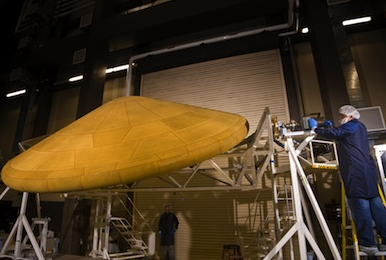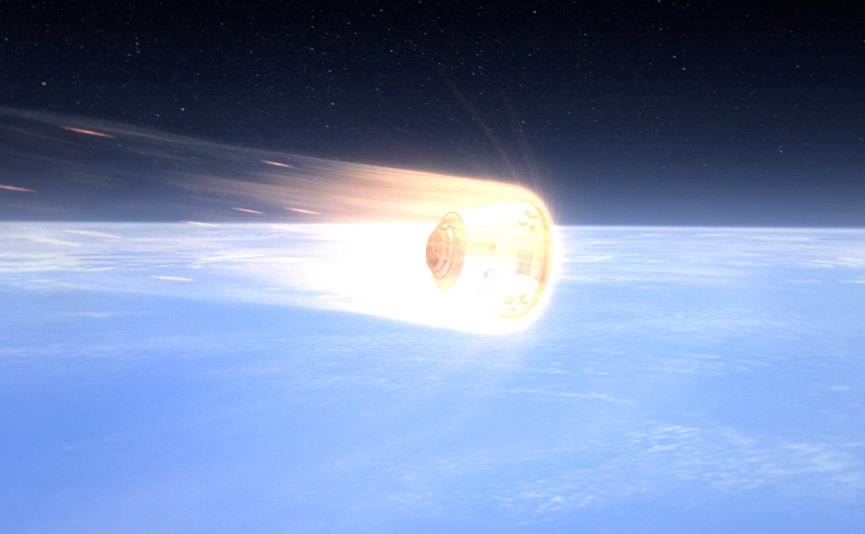Last summer the Mars Science Laboratory (MSL) safely landed on the rocky surface of Mars. One of the key components in the successful landing of its rover, Curiosity, was the Thermal Protection System (TPS), or the heat shield on the spacecraft that carried the rover.
One memory the world has about the heat shield is when it sprung off the spacecraft and shot across the Martian terrain. At an impressive 15 feet in diameter, it's the largest heat shield to ever travel to another planet, but that didn't necessarily make it a good thing. Though more resistance can certainly act as a natural braking system, the massive heat build up on the spacecraft was seriously hot, at a boiling 3,360ºF.
To protect against this kind of heat, the rigid, lightweight material, Phenolic Impregnanted Carbon Ablator (PICA), a carbon fiber preform impregnated in phenolic resin, was developed at the NASA Ames Research Center in Moffett Field, CA. PICA was introduced on the Stardust return capsule, which was used to bring back comet particles and interstellar dust samples to Earth back in January 2006.

The PICA heat shield before it flew with NASA's Mars Science Laboratory mission. Image via spaceflightnow.com.
“Mars Curiosity in fact had a full body heat shield,” said Dan Rasky, Director and Co-founder of the Space Portal. “It actually enabled the mission as it turns out because the standard heat shield for Mars entry is something that was developed in the '70s for the Viking lander called SLA 561, and it turns out that it wasn't going to work for Mars Curiosity.”
According to Rasky, the heat from Mars Curiosity was going to be extraordinary. When NASA tested their heat shield, they found it wouldn't work.
“It was literally there one minute and gone the next,” said Rasky. “It was a bit of a scramble to find a replacement in time to be able to make the mission and so we went from the standard Mars heat shield to PICA and PICA worked very, very well and all of that eventually saved the mission.”
Because the MSL heat shield was so large, a tiled version of PICA was developed and the tiles were placed on a molded carbon-composite carrier structure.
“The carbon tiles actually come from the vacuum furnace industry,” said Rasky. “They use it as insulation for vacuum furnaces. So once you put the phenolic in it, that's now less applicable for a vacuum furnace where you could have vaporization occur if you pulled the full vacuum on the phenolics,” he said. “PICA, I think, or heat-shielding applications particularly for any type of abort system has to have some protection in case it burns up.”
The heat shield also had two suites of sensors installed on it. The first recorded atmospheric data and TPS performance and the second were pressure sensors that enabled a reconstruction of the flight trajectory as the spacecraft headed toward the surface of Mars.
Between the 2006 Stardust and the 2012 MLS landing, PICA was used on another spacecraft, the SpaceX Dragon. The Dragon's heat shield, measuring 13 feet, is slightly smaller than that of the MSL. In early 2009, SpaceX announced successful arc jet testing of three variations of the NASA PICA material, and so the PICA-X, the SpaceX version of PICA, was developed with the help of NASA at the Ames Research Center.
PICA-X has several improvements over PICA. According to Rasky, it's made at a fraction of the cost of NASA's PICA and it also represents greater ease of manufacturing. Produced in large pieces and then cut into tiles, they're placed on to a carbon-composite mold, similar to way the MSL's heat shield was made. Impressively, the shield on PICA-X is strong enough that only about half an inch burns off during re-entry, insuring safety for both astronauts and cargo. This makes PICA-X reusable—it can be used dozens of times for re-entry into Earth's atmosphere.

An artist's rendition of the PICA-X heat shield protecting the Dragon spacecraft as it re-enters Earth's atmosphere at around 15,660 MPH. Image via NASA.

Want to go behind the scenes with NASA? Littelfuse has created an Exploration & Discovery Experience for the engineering community as part of its 2013 Speed2Design program. Winning design engineers will get the opportunity to spend time with NASA engineers at two NASA facilities and learn about the latest in space technology. For more information and to enter, visit speed2design.com.
Advertisement
Learn more about Electronic Products MagazineNasa





